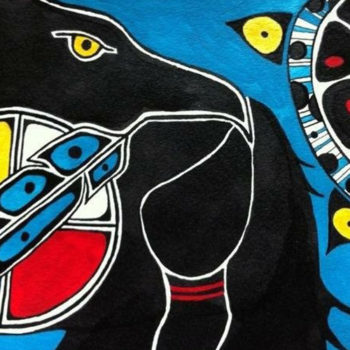The canvas of our ever-changing lives
I have two great-nieces that visit me often. I always ensure that I am stocked with Indigenous children’s books and craft supplies for them to explore. Last summer, I purchased illustrated canvases. Layna, the older one, purposely chose what colours she’d use in her painting and made every effort to make sure the paint would not go outside the lines. Meanwhile, Little Lacey just went with the flow and seemed to investigate the paints and mixing of colours. As you can see in the accompanying photo (below right), Lacey has a mishmash of colours that don’t necessarily stay in the lines (and why should they?). This painting, or the creation of it, was the inspiration of how I would deliver a workshop for our members on Issues Facing First Nations, Métis and Inuit Members. It is impossible to fit a whole history into a 90-minute presentation, but it was possible to capture the essence of some of these experiences through an activity.
A painting created by Lacey, one of
Rachel’s great‑nieces
To begin, I’d like you to think about your life experiences. Every one of us is in constant motion of interacting with new experiences – either positive, negative, neutral, by chance or by choice. These experiences include our interactions with people, communities, the environment or situations. Some of these interactions can be meaningless, while others are very meaningful. It is these experiences that shape us in our thinking, behaviours, actions, reactions, expressions, attitudes, etc. We are in constant flux. We’ve been exposed to these since the day we were born. What we experience in our lives cannot be undone. It has already happened. What we choose to do with these experiences is up to us, individually. How we choose to impact the experience of others, through our interactions, is also up to us.
Now imagine this. We are each a canvas. Some canvases may have an image already drawn on it, depicting the expectations others have on us, or our dreams of what we want to be or do someday. From the day we are born, colour is added. If every new experience, like those mentioned, was a different colour, there would be an influx of colours added to your canvas daily. There are also many painters with brushes applying colours to your canvas. The colours on the canvas would mix with each other or colours would be painted over, constantly. When the paint covers an existing colour, does it mean it was never there? No. It’s still there. It’s just now covered with another colour.
Rachel’s mother with three of Rachel’s great‑nieces.
If our experiences and our lives were like this colourful canvas, we can look at how our experiences have shaped us. We can also see how many painters have made their marks on us as well. Who were the primary painters for your canvas? Based on the experiences you’ve had, what are the most prominent colours and what do they represent? In the workshop, I invited members to write down the names of people, experiences and/or statements that impacted or influenced them.
Later, I showed an image of a child finger painting and then made the correlation between the paint and our experiences, and how these have shaped us.
My presentation also included an overview of the Royal Proclamation of 1763, section 91(24) of the Constitution Act (1982), sections 25 and 35 of the Canadian Charter of Rights and Freedoms, the Ontario Human Rights Code, and the United Nation Declaration on the Rights of Indigenous Peoples (2007). Following this, I included snapshot images of recent newspaper headlines that involved Indigenous Peoples in Canada. The headline topics covered a wide spectrum of issues, including: child welfare, access to clean drinking water, housing conditions and poverty, racism in health care and public services, missing and murdered Indigenous women, trauma, addictions, suicide, the Sixties Scoop, and Toronto’s March 2017 issue of Now Magazine that highlights Indigenous perspectives and the apprehension of celebrating Canada 150. I also included newspaper images of Indigenous Peoples from around the world who were publicly demonstrating their choice to not stand for the national anthem in their respective country, a choice that Indigenous children in our schools also have (respectfully and rightfully so).
I also shared my personal experience of not having the luxury of reading the news and not hearing about issues that are still prevalent for Indigenous Peoples today. These issues, no matter where in Canada, impact me, my family, my people, my community, and other Indigenous Peoples because of our collective ties to our lands, our rights, and our relationship with Canada. These issues stem from an imbalanced relationship with the government that goes way back and continues still to this day. There are many layers. Indigenous Peoples are demanding equity and justice – there is no painting within the lines here.
I regrouped the workshop members to focus on the concept of the painting analogy, how our experiences have shaped us in who we are, what we stand for, and how we become a part of someone else’s experience. There are many layers to our experiences. As painters, we have the choice to decide what colours and designs we are going to add to another person’s canvas and experience. As union members and educators, we have the power to create learning and working environments that are inclusive of Indigenous Peoples. You have the choice to be an ally and make a commitment to learning about these issues and experiences that impact Indigenous Peoples. We have a lot to learn about each other and I believe we can create a more inclusive Canada by understanding our history and painting a future that will leave a lasting and powerful imprint on others regarding the need for equity and justice for Indigenous Peoples.




